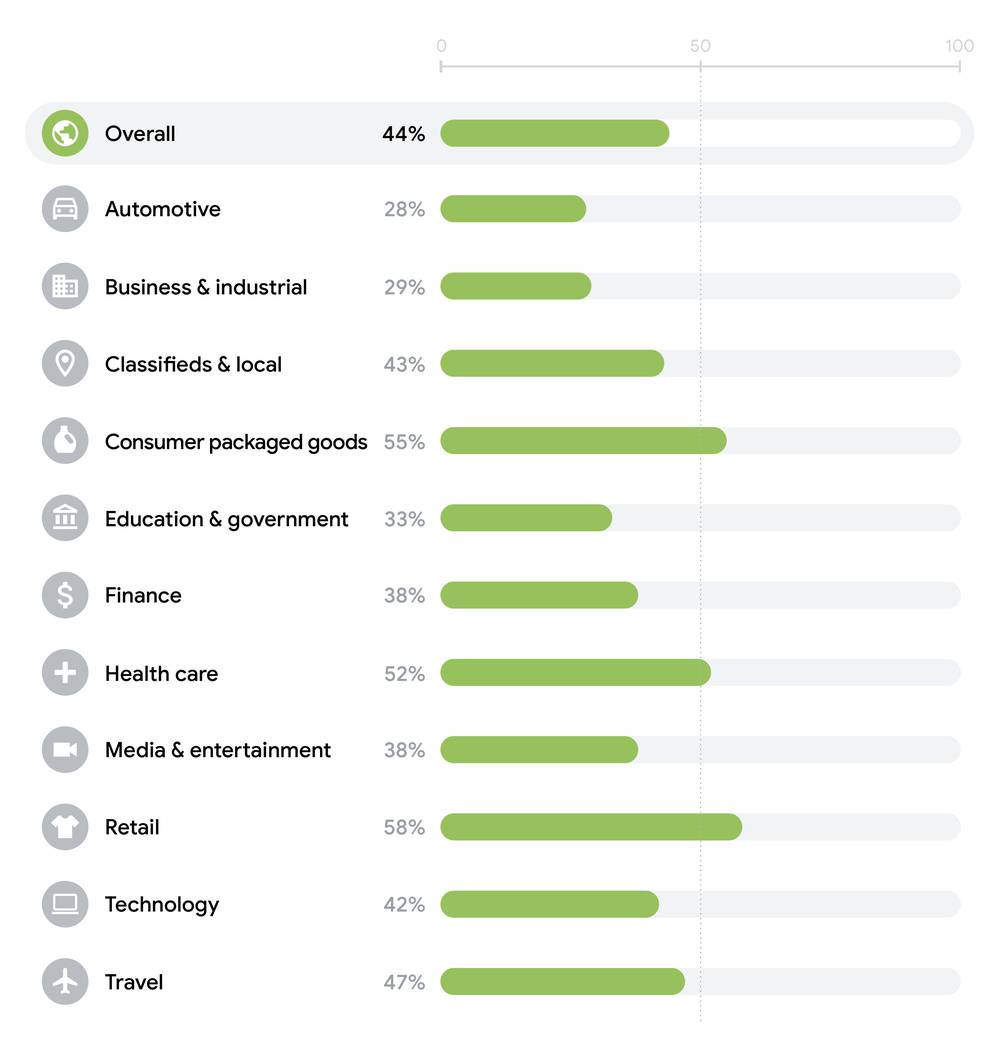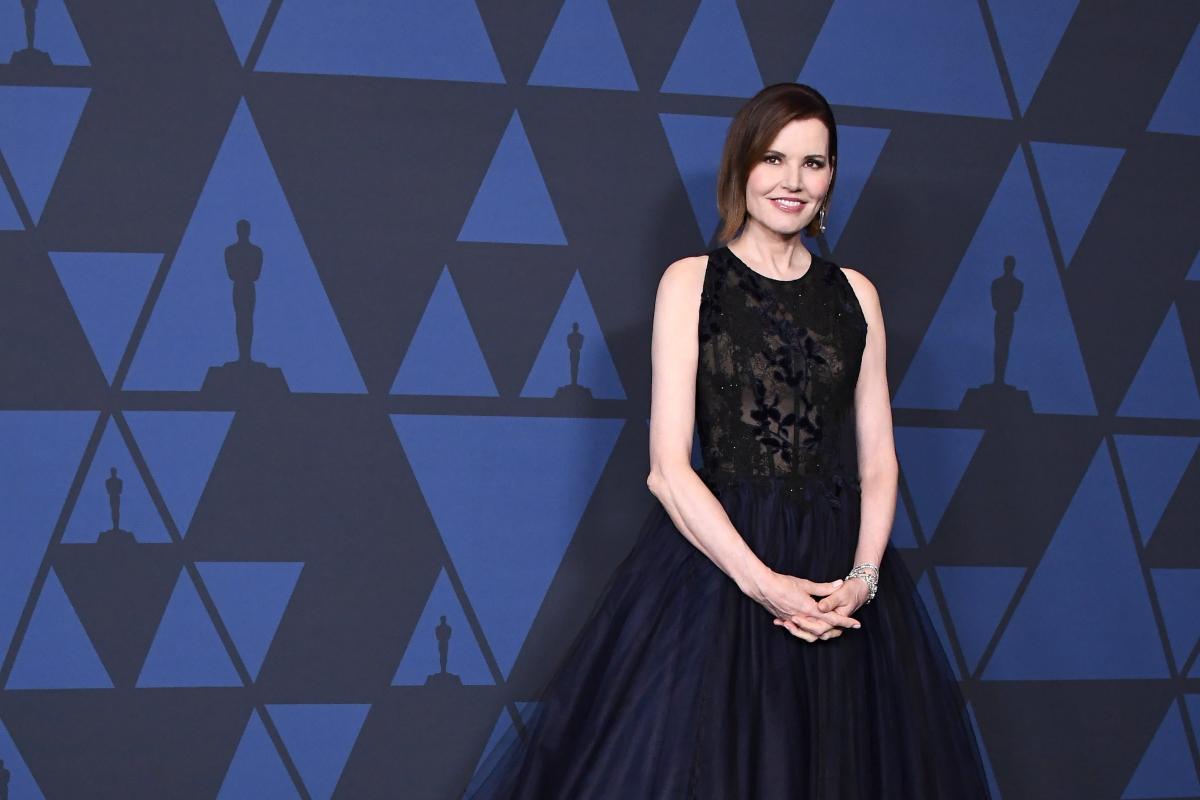Think with Google
Source: GDIGM/Google, Global, Study of gender representation in over 2.7 million videos across 11 verticals, uploaded between Jan. 2015–May 2019.
Of the millions of ads analysed that were aggregated globally, we found that people saw male characters 56% of the time and female characters 44% of the time. But overall, women-led and gender-balanced videos yielded 30% more views than other videos, revealing a demand for more inclusive content.
Percentage of screen time for female characters in YouTube ads

Think with Google
Source: GDIGM/Google, Global, Study of gender representation in over 2.7 million videos across 11 verticals, uploaded between Jan. 2015–May 2019.
When we look at advertising sectors individually, we found that people saw female characters in automotive ads 28% of the time, and 29% of the time in business and industrial ads. While in education and government ads, people saw female characters 33% of the time. However, we found that people saw female characters 52% of the time in health care ads. The greatest presence of female characters was seen in retail ads, accounting for 58% of the time, and female characters were seen in consumer packaged goods ads 55% of the time.
Percentage of speaking time for female characters in YouTube ads

Think with Google
Source: GDIGM/Google, Global, Study of gender representation in over 2.7 million videos across 11 verticals, uploaded between Jan. 2015–May 2019
Similar to screen time, gender gaps persist in speaking time. Overall, male characters were heard 1.5X more often than female characters (60% compared to 40%). When it comes to individual advertising sectors, we see a more pronounced gender gap, with women speaking less in ads for education and government (26% women), automotive (24% women) and business and industrial (21% women). Female and male characters have roughly equal speaking time in retail (54%), consumer packaged goods (52%), and health care (49%) ads on YouTube.
Our analysis shows that gender bias in advertising is compounded by age bias. Female characters are more likely to be in their 20s and 30s in ads, while male characters are shown across age groups. Globally, male characters are an average of four years older than female characters in ads. Also, over the five years examined, the average age of female characters stayed relatively consistent while male characters got older.
We also conducted a deeper dive into the top 100 viewed global ads across 11 advertising sectors and discovered that female characters are significantly more likely to wear revealing clothing than male characters, and are shown more often in the kitchen, shopping and cleaning. In contrast, male characters are more likely to be shown driving, working, outdoors and attending a sporting event. Male characters are also more likely to be shown working and in leadership positions. When our youngest children disproportionately see men in the boardroom and women in the kitchen, this sends a clear message reinforcing negative stereotypes about the value of women and girls in society.
Looking forward
Gender bias in media is not news to women. According to a study from J. Walter Thompson’s Female Tribes initiative, 85% of women think the advertising world needs to catch up to the real world when it comes to gender roles, and 66% switch off media when it stereotypes women negatively.
What’s more, audiences respond to inclusive storytelling. We found that YouTube videos uploaded by advertisers featuring at least as many female characters as male yielded 30% more views than other videos, telling us that when advertisers make their creative more inclusive, people watch. There's an appetite for stories that truly reflect the complexity and diversity of our world. Brands that respect that diversity will earn the trust of their audiences.
From over a decade of advocacy, I’ve learned that providing data-driven research is the most effective intervention tool for achieving systemic change. By quantifying patterns of gender bias in ads and sharing our findings with the industry at large, we are motivating advertisers to evaluate the inclusiveness of their work, identify unconscious bias and engage in conversations around representation with their teams.
I’m incredibly proud of the work that we’ve done and all that we’ve accomplished since I first sat down on that couch with my daughter. After all, our motto has always been, “If she can see it, she can be it.”
This piece first appeared on Think With Google's site here.
This article was originally published on Think with Google. Insights, Ideas and Inspiration. Take your marketing further with Google.
Receive regular updates from Think with Google
[https://getsubscriptions.withgoogle.com/intl/en-gb/newsletter/signup/landing/]



